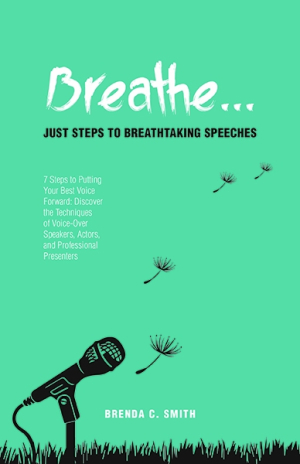
Breathe... Just Steps to Breathtaking Speeches
7 Steps to Putting Your Best Voice Forward: Discover the Techniques of Voice-Over Speakers, Actors, and Professional Presenters
These exercises are highly targeted to strengthening the voice to improve presentations.
Brenda Smith’s Breathe … Just Steps to Breathtaking Speeches employs a simple seven-step process to help anyone employ their voice more effectively in business.
In this useful how-to book, Smith, a voice coach, offers a comprehensive program for improving one’s speaking voice with an emphasis on making better business presentations. Her method, cleverly centered around the acronym BREATHE, is comprised of seven steps: breathe, relax, energize, articulate, tone, humanize, engage.
Dividing the book into three parts (“Preparation,” “Presence,” and “Performance”), Smith devotes a chapter to each of the seven steps. She explores every step in considerable detail, including the benefits of each, helpful diagrams where they are appropriate, examples from her work with voice clients, and most importantly, specific step-by-step exercises.
Ideally, the seven steps will be followed sequentially, but each chapter feels self-contained, so it is conceivable that a step could be used individually, depending upon where the speaker needs the most work. Clearly, however, Smith wants the first step, breathing, to be of primary importance. “Your breath,” she writes, “is a management tool, your own CEO, and your best ally for enhancing your speech and vocal sound.” In this chapter, Smith teaches the fine points of diaphragmatic breathing. The author later points out that this breathing technique is not just valuable for improving voice quality, but also for calming nerves.
One of the more unique aspects of the book is the sensitivity Smith shows in dealing with various challenges for speakers. For example, she includes a section with the header “How do women avoid breaking down in front of others?” in which she empathetically confronts the issue of how a woman can control her voice when emotion takes over. Smith offers three strategies to address this challenge: “consciously breathe,” “lower your vocal tone,” and “slow your pace.” Smith suggests, “These three strategies work together as a team to overpower the emotional side that makes you look vulnerable.”
Breathe … is full of tips and techniques for learning how to use the voice as a tool, with an emphasis on voice exercises. Some of these are inspired by exercises utilized by actors and professional voice-over artists. As such, they demand careful attention to detail and a dedication to practice, but Smith is a positive and motivational guide.
It should be pointed out that this is not a book that will help one improve the content of a presentation. Instead, the emphasis is entirely on presentation quality with regard to one’s voice.
Smith writes well, her client stories are relevant, and the exercises are highly targeted to strengthening the voice. As Smith concludes, “These are tools to elevate your presentations from ordinary to extraordinary.” Those who are willing to do the work should find that Breathe … delivers on its promises.
Reviewed by
Barry Silverstein
Disclosure: This article is not an endorsement, but a review. The publisher of this book provided free copies of the book and paid a small fee to have their book reviewed by a professional reviewer. Foreword Reviews and Clarion Reviews make no guarantee that the publisher will receive a positive review. Foreword Magazine, Inc. is disclosing this in accordance with the Federal Trade Commission’s 16 CFR, Part 255.
